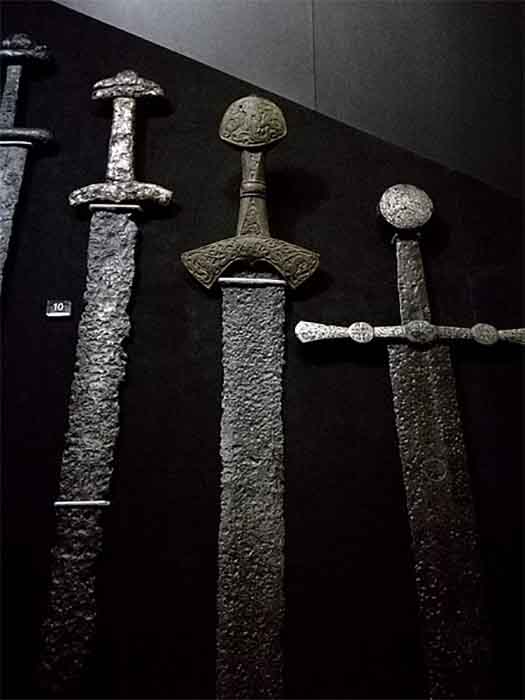A new study claims to have solved the mystery of non-binary gender evidence at a medieval warrior grave.
In 1968, in the village of Suontaka Vesitorninmäki in southern Finland, a warrior’s grave dated to the 11th century was discovered. The grave contained a woman in a dress and three brooches, along with a massive sword.
53 years later, it has been subjected to a modern re-analysis which “challenges the traditional beliefs about gender roles in the Iron Age and Early Medieval communities and reveals information about the gender expressions of the period”, reports Phys.org. This grave is now the subject of a radical revisionist study published online by the Cambridge University Press in the reputed European Journal of Archaeology.
The Grave and the Warrior
The region of Häme, where the village is located, is renowned for its numerous archaeological sites and the many swords found there. For many years this particular grave has been seen as clinching evidence of early medieval Finland being a time of powerful women leaders , who appeared to be warriors.
Using content examination, soil sampling for micro-remains and an ancient DNA (aDNA) analysis to deduce the chromosomal sex of the individual, a new interpretation and hypothesis has been brought forward. This hypothesis points to the buried person being non-binary!

The Grave ( Cambridge University Press )
Stemming from that, such a dignified burial would indicate that non-binary people were valued and respected members of their communities. The warrior in this grave was buried with beautiful jewelry and dressed in clothes that were typical of the women of this period. The dual sword burial (the remains of a second sword have been found within the same grave), by way of contrast, are symbols of masculinity.
“The buried individual seems to have been a highly respected member of their community. They had been laid in the grave on a soft feather blanket with valuable furs and objects,” says Ulla Moilanen, Doctoral Candidate of Archaeology from the University of Turku, Finland.
The contents of this grave have long puzzled archaeologists – after all the two swords would indicate perhaps that both a man and a woman were buried together, with either of their swords to take with them into the afterlife. Others argued that it was a strong woman leader or warrior who was buried alone and had two swords buried with her to indicate her power and prestige in Late Iron Age Finland.
Opposing Gender Norms
The study notes “an enduring fascination” at what is found here: symbols of feminine power buried alongside masculine weaponry. At the same time the study firmly opposes the traditional interpretation of grave digs, which are gendered according to the goods found in them. Additionally, new forms of theory regarding gender and identity, developed from the 1970s onwards, began delinking the socio-cultural construct of gender versus the biological determination of sex as a scientific classification.
Theorists like Judith Butler furthered this argument in the 1990s and argued that gender is a performance conducted on societal-based expectations. “The binary division of sexes is arguably rooted in a modern, western mindset, and gendered norms and expectations have varied culturally, geographically, and temporally”, they write in the study.

Suontaka in southern Finland, where the grave is located ( Cambridge University Press )
The DNA was badly damaged, but the analysis suggested that the buried individual had the sex-chromosomal aneuploidy XXY, also known as Klinefelter syndrome. This is a genetic condition in which a male is born with an extra copy of the X chromosome, due to a result of some random genetic errors. Klinefelter syndrome is known to result in feminine characteristics such as diminished muscle mass or breast growth , and can also result in infertility.
Their Place in Society
“According to current data, it is likely that the individual found in Suontaka had the chromosomes XXY, although the DNA results are based on a very small set of data,” says Postdoctoral Researcher Elina Salmela from the University of Helsinki, Finland.
Moilanen adds that “If the characteristics of the Klinefelter syndrome have been evident on the person, they might not have been considered strictly a female or a male in the Early Middle Ages community. The abundant collection of objects buried in the grave is a proof that the person was not only accepted but also valued and respected. However, biology does not directly dictate a person’s self-identity.”

The famous Sword of Suontaka, found in the grave (Velivieras / CC BY-SA 4.0 )
Finally, the team conducting the study also attempted to solve the mystery of the second sword found in the grave. According to Moilanen, only one of the two swords is part of the original burial. The hiltless bronze-handled sword was probably added to the grave much later, perhaps another symbolic assertion of how important the deceased person was to the community.
Top image: The research suggests that a re-evaluation of gender in Iron Age society is required. Source: Nejron Photo / Adobe Stock.
By Sahir Pandey
 RSS Feed
RSS Feed















 August 1st, 2021
August 1st, 2021  Awake Goy
Awake Goy  Posted in
Posted in  Tags:
Tags: 













